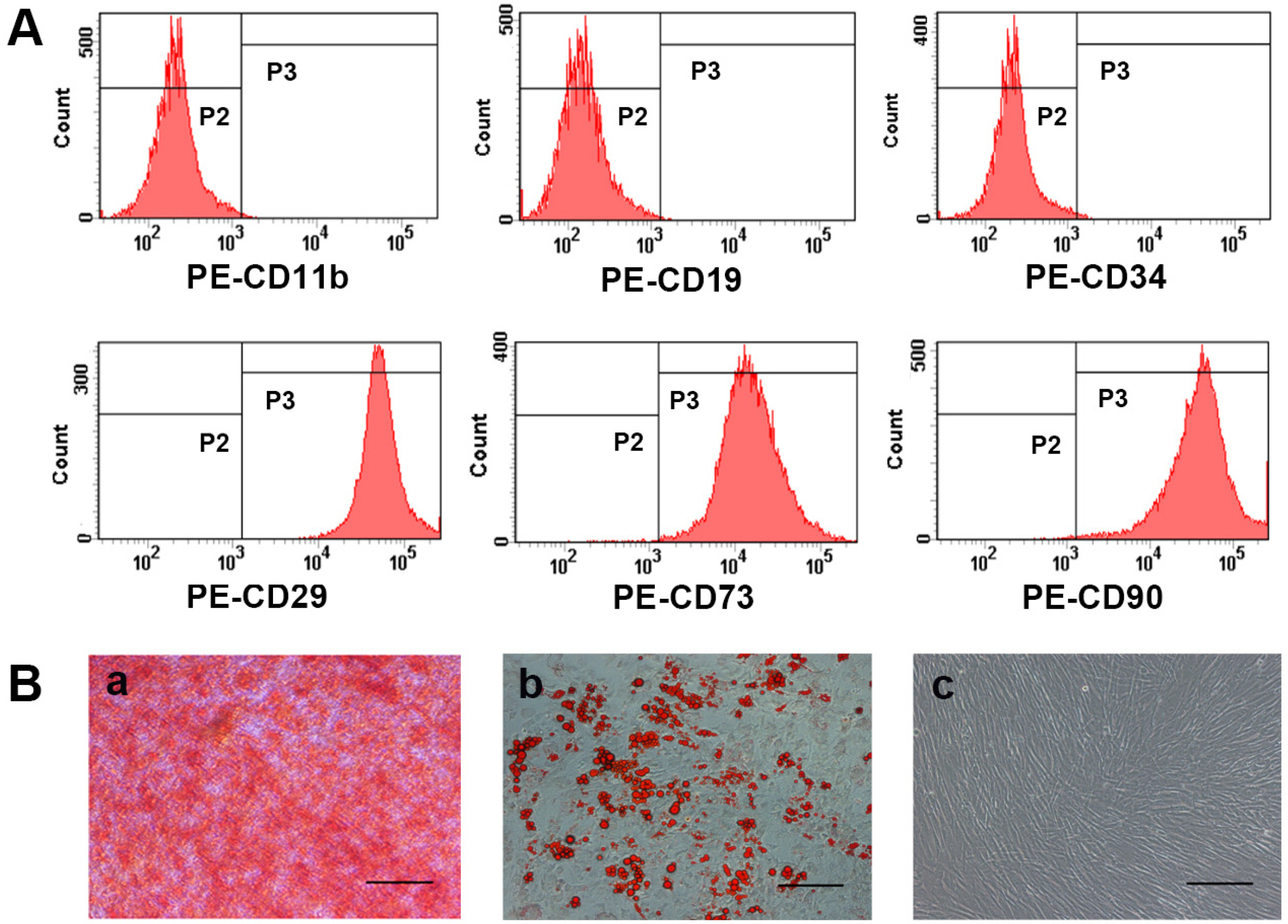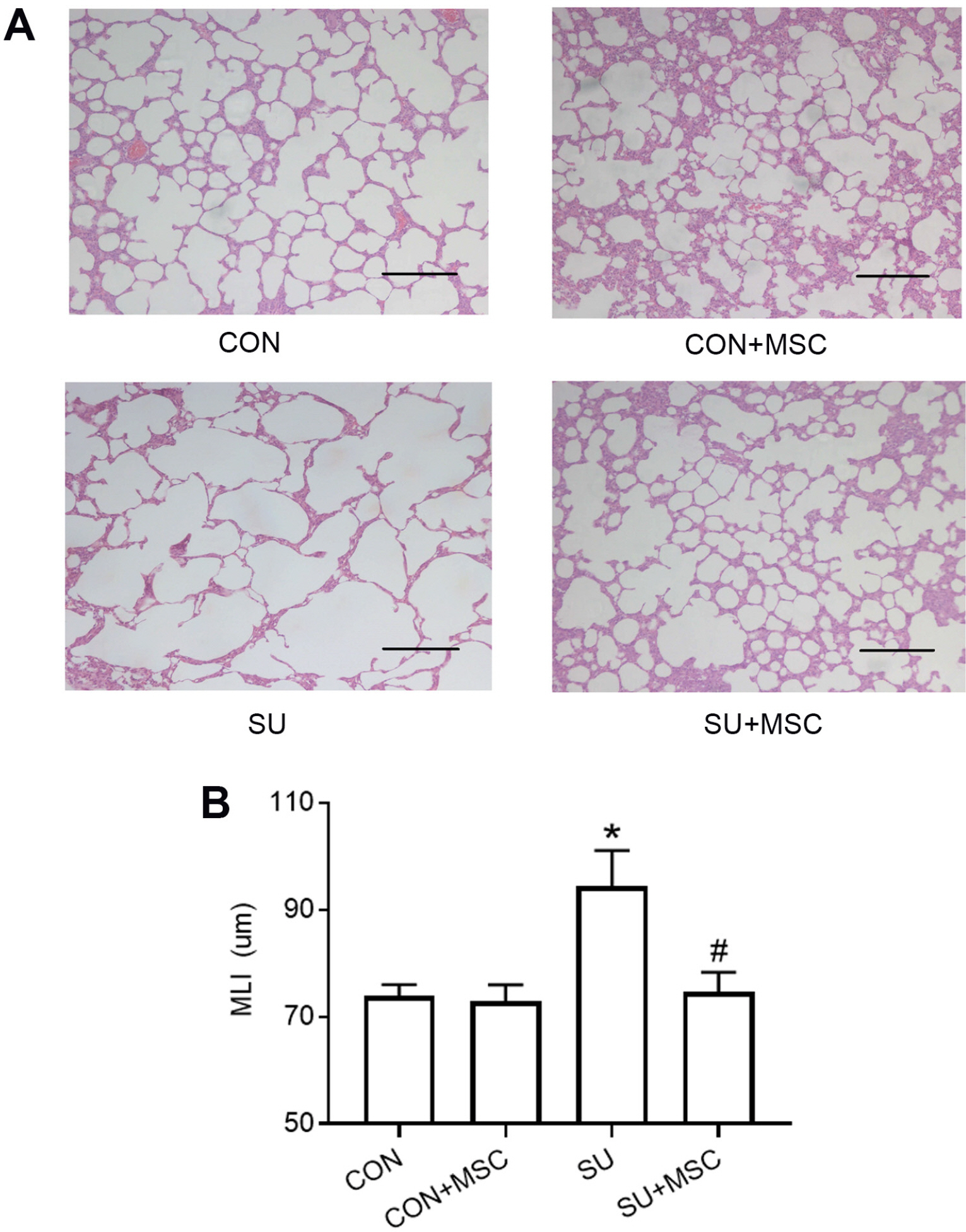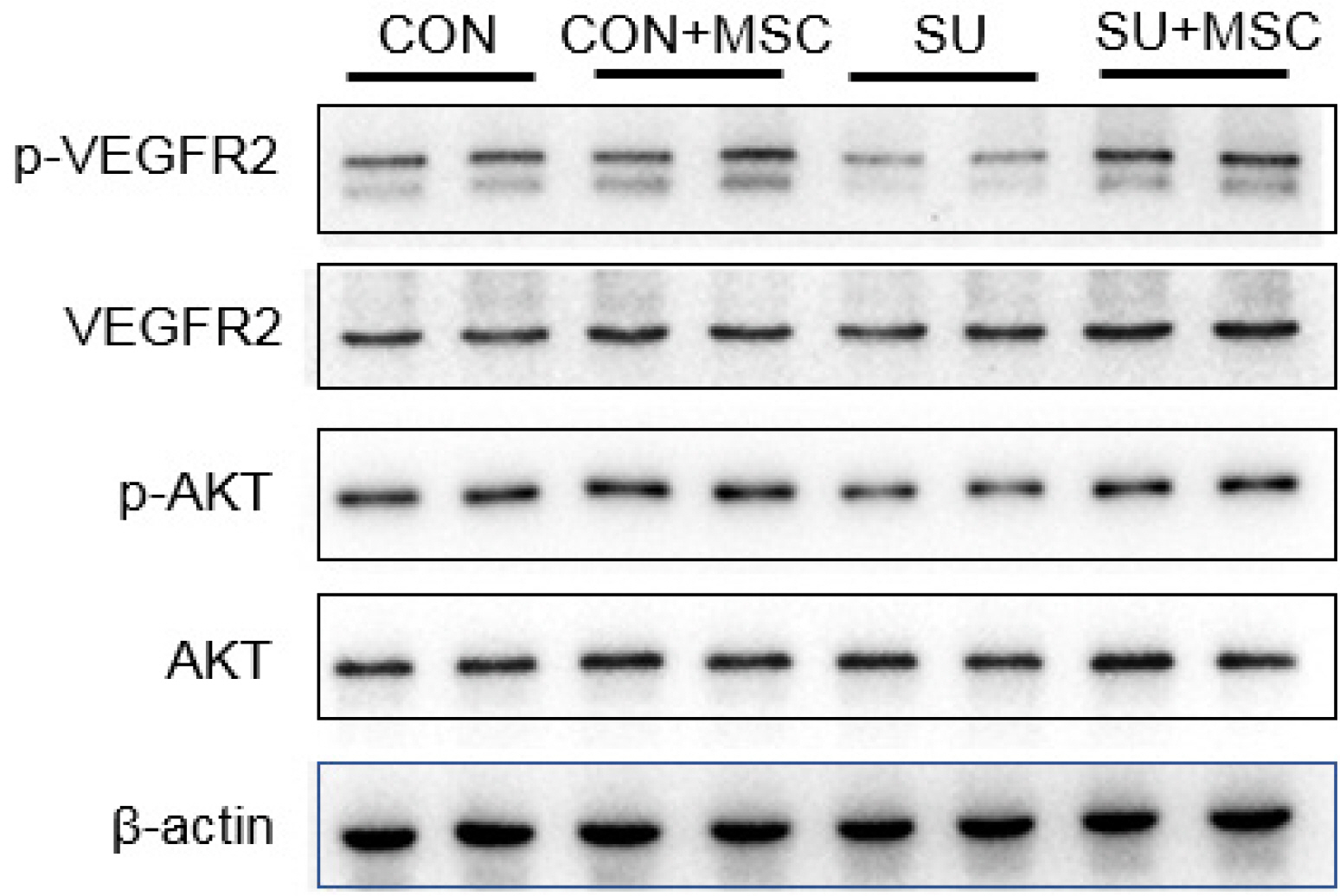Int J Stem Cells.
2022 Nov;15(4):395-404. 10.15283/ijsc21149.
Human Umbilical Cord-Derived Mesenchymal Stem Cells Repair SU5416-Injured Emphysema by Inhibiting Apoptosis via Rescuing VEGF-VEGFR2-AKT Pathway in Rats
- Affiliations
-
- 1Laboratory Center, Affiliated People’s Hospital of Jiangsu University, Zhenjiang, China
- 2Department of Cardiothoracic Surgery, Affiliated People’s Hospital of Jiangsu University, Zhenjiang, China
- 3Department of Otolaryngology-Head and Neck Surgery, Affiliated People’s Hospital of Jiangsu University, Zhenjiang, China
- KMID: 2536209
- DOI: http://doi.org/10.15283/ijsc21149
Abstract
- Background and Objectives
Chronic obstructive pulmonary disease (COPD) is a common, frequently-occurring disease and poses a major health concern. Unfortunately, there is current no effective treatment for COPD, particularly emphysema. Recently, experimental treatment of COPD using mesenchymal stem cells (MSCs) mainly focused on bone marrow-derived MSCs (BM-MSCs). Human umbilical cord-derived MSCs (hUC-MSCs) have more advantages compared to BM-MSCs. However, studies on the role of hUC-MSCs in management of COPD are limited. This study sought to explore the role of hUC-MSCs and its action mechanisms in a rat model of VEGF receptor blocker SU5416-injured emphysema.
Methods and Results
hUC-MSCs were characterized by immunophenotype and differentiation analysis. Rats were div-ided into four groups: Control, Control+MSC, SU5416 and SU5416+MSC. Rats in model group were administered with SU5416 for three weeks. At the end of the second week after SU5416 administration, model group were infused with 3×106 hUC-MSCs through tail vein. After 14 days from hUC-MSCs transplantation, rats were euthanized and data were analyzed. HE staining and mean linear intercepts showed that SU5416-treated rats exhibited typical emphysema while emphysematous changes in model rats after hUC-MSCs transplantation disappeared completely and were restored to normal phenotype. Furthermore, hUC-MSCs inhibited apoptosis as shown by TUNEL and Western blotting. ELISA and Western blotting showed hUC-MSCs rescued VEGF-VEGFR2-AKT pathway in emphysematous lungs.
Conclusions
The findings show that hUC-MSCs effectively repair the emphysema injury. This study provides the first evidence that hUC-MSCs inhibit apoptosis via rescuing VEGF- VEGFR2-AKT pathway in a rat model of emphysema.
Figure
Reference
-
References
1. Rabe KF, Watz H. 2017; Chronic obstructive pulmonary disease. Lancet. 389:1931–1940. DOI: 10.1016/S0140-6736(17)31222-9. PMID: 28513453. PMID: https://www.scopus.com/inward/record.uri?partnerID=HzOxMe3b&scp=85018884308&origin=inward.
Article2. Matthay MA, Thompson BT, Read EJ, McKenna DH Jr, Liu KD, Calfee CS, Lee JW. 2010; Therapeutic potential of mesenchymal stem cells for severe acute lung injury. Chest. 138:965–972. DOI: 10.1378/chest.10-0518. PMID: 20923800. PMCID: PMC2951759. PMID: https://www.scopus.com/inward/record.uri?partnerID=HzOxMe3b&scp=77957838550&origin=inward.
Article3. O'Reilly M, Thébaud B. 2012; Cell-based strategies to reconstitute lung function in infants with severe bronchopulmonary dysplasia. Clin Perinatol. 39:703–725. DOI: 10.1016/j.clp.2012.06.009. PMID: 22954277. PMCID: PMC7112346. PMID: https://www.scopus.com/inward/record.uri?partnerID=HzOxMe3b&scp=84865735417&origin=inward.4. Weiss DJ, Bertoncello I, Borok Z, Kim C, Panoskaltsis-Mortari A, Reynolds S, Rojas M, Stripp B, Warburton D, Prockop DJ. 2011; Stem cells and cell therapies in lung biology and lung diseases. Proc Am Thorac Soc. 8:223–272. DOI: 10.1513/pats.201012-071DW. PMID: 21653527. PMCID: PMC3132784. PMID: https://www.scopus.com/inward/record.uri?partnerID=HzOxMe3b&scp=80051755198&origin=inward.
Article5. Gu W, Song L, Li XM, Wang D, Guo XJ, Xu WG. 2015; Mesenchymal stem cells alleviate airway inflammation and emphysema in COPD through down-regulation of cyclooxygenase-2 via p38 and ERK MAPK pathways. Sci Rep. 5:8733. DOI: 10.1038/srep08733. PMID: 25736434. PMCID: PMC4348625. PMID: https://www.scopus.com/inward/record.uri?partnerID=HzOxMe3b&scp=84924127186&origin=inward.
Article6. Zhen G, Liu H, Gu N, Zhang H, Xu Y, Zhang Z. 2008; Mesenchymal stem cells transplantation protects against rat pulmonary emphysema. Front Biosci. 13:3415–3422. DOI: 10.2741/2936. PMID: 18508443. PMID: https://www.scopus.com/inward/record.uri?partnerID=HzOxMe3b&scp=42649127352&origin=inward.
Article7. Tibboel J, Keijzer R, Reiss I, de Jongste JC, Post M. 2014; Intravenous and intratracheal mesenchymal stromal cell injection in a mouse model of pulmonary emphysema. COPD. 11:310–318. DOI: 10.3109/15412555.2013.854322. PMID: 24295402. PMCID: PMC4046870. PMID: https://www.scopus.com/inward/record.uri?partnerID=HzOxMe3b&scp=84900811078&origin=inward.
Article8. Bustos ML, Huleihel L, Kapetanaki MG, Lino-Cardenas CL, Mroz L, Ellis BM, McVerry BJ, Richards TJ, Kaminski N, Cerdenes N, Mora AL, Rojas M. 2014; Aging mesenchymal stem cells fail to protect because of impaired migration and antiinflammatory response. Am J Respir Crit Care Med. 189:787–798. DOI: 10.1164/rccm.201306-1043OC. PMID: 24559482. PMCID: PMC4061541. PMID: https://www.scopus.com/inward/record.uri?partnerID=HzOxMe3b&scp=84897403227&origin=inward.
Article9. Nagamura-Inoue T, He H. 2014; Umbilical cord-derived mesenchymal stem cells: their advantages and potential clinical utility. World J Stem Cells. 6:195–202. DOI: 10.4252/wjsc.v6.i2.195. PMID: 24772246. PMCID: PMC3999777.
Article10. Hao Y, Ran Y, Lu B, Li J, Zhang J, Feng C, Fang J, Ma R, Qiao Z, Dai X, Xiong W, Liu J, Zhou Q, Hao J, Li R, Dai J. 2018; Therapeutic effects of human umbilical cord-derived mesenchymal stem cells on canine radiation-induced lung injury. Int J Radiat Oncol Biol Phys. 102:407–416. Erratum in: Int J Radiat Oncol Biol Phys 2019;103:287. DOI: 10.1016/j.ijrobp.2018.10.012. PMID: 30563665. PMID: https://www.scopus.com/inward/record.uri?partnerID=HzOxMe3b&scp=85057876245&origin=inward.
Article11. Moroncini G, Paolini C, Orlando F, Capelli C, Grieco A, Tonnini C, Agarbati S, Mondini E, Saccomanno S, Goteri G, Svegliati Baroni S, Provinciali M, Introna M, Del Papa N, Gabrielli A. 2018; Mesenchymal stromal cells from human umbilical cord prevent the development of lung fibrosis in immunocompetent mice. PLoS One. 13:e0196048. DOI: 10.1371/journal.pone.0196048. PMID: 29856737. PMCID: PMC5983506. PMID: https://www.scopus.com/inward/record.uri?partnerID=HzOxMe3b&scp=85048051579&origin=inward.
Article12. Liu L, Mao Q, Chu S, Mounayar M, Abdi R, Fodor W, Padbury JF, De Paepe ME. 2014; Intranasal versus intraperitoneal delivery of human umbilical cord tissue-derived cultured mesenchymal stromal cells in a murine model of neonatal lung injury. Am J Pathol. 184:3344–3358. DOI: 10.1016/j.ajpath.2014.08.010. PMID: 25455688. PMID: https://www.scopus.com/inward/record.uri?partnerID=HzOxMe3b&scp=84913549477&origin=inward.
Article13. Shu L, Niu C, Li R, Huang T, Wang Y, Huang M, Ji N, Zheng Y, Chen X, Shi L, Wu M, Deng K, Wei J, Wang X, Cao Y, Yan J, Feng G. 2020; Treatment of severe COVID-19 with human umbilical cord mesenchymal stem cells. Stem Cell Res Ther. 11:361. DOI: 10.1186/s13287-020-01875-5. PMID: 32811531. PMCID: PMC7432540. PMID: 6c966823e1b5408da96adf6148c7685a. PMID: https://www.scopus.com/inward/record.uri?partnerID=HzOxMe3b&scp=85089643262&origin=inward.
Article14. Le Thi Bich P, Nguyen Thi H, Dang Ngo Chau H, Phan Van T, Do Q, Dong Khac H, Le Van D, Nguyen Huy L, Mai Cong K, Ta Ba T, Do Minh T, Vu Bich N, Truong Chau N, Van Pham P. 2020; Allogeneic umbilical cord-derived mesenchymal stem cell transplantation for treating chronic obstructive pulmonary disease: a pilot clinical study. Stem Cell Res Ther. 11:60. DOI: 10.1186/s13287-020-1583-4. PMID: 32054512. PMCID: PMC7020576. PMID: c3c14a9881b8478aa7765d3bf9cc9da2. PMID: https://www.scopus.com/inward/record.uri?partnerID=HzOxMe3b&scp=85079338721&origin=inward.
Article15. Cho JW, Park KS, Bae JY. 2019; Effects of Wharton's jelly-derived mesenchymal stem cells on chronic obstructive pulmonary disease. Regen Ther. 11:207–211. DOI: 10.1016/j.reth.2019.07.009. PMID: 31489344. PMCID: PMC6715889. PMID: https://www.scopus.com/inward/record.uri?partnerID=HzOxMe3b&scp=85070979069&origin=inward.
Article16. Ridzuan N, Zakaria N, Widera D, Sheard J, Morimoto M, Kiyokawa H, Mohd Isa SA, Chatar Singh GK, Then KY, Ooi GC, Yahaya BH. 2021; Human umbilical cord mesenchymal stem cell-derived extracellular vesicles ameliorate airway inflammation in a rat model of chronic obstructive pulmonary disease (COPD). Stem Cell Res Ther. 12:54. DOI: 10.1186/s13287-020-02088-6. PMID: 33436065. PMCID: PMC7805108. PMID: b578f88ff1d740f1ac709eb36548bdc2. PMID: https://www.scopus.com/inward/record.uri?partnerID=HzOxMe3b&scp=85099226302&origin=inward.
Article17. Kasahara Y, Tuder RM, Taraseviciene-Stewart L, Le Cras TD, Abman S, Hirth PK, Waltenberger J, Voelkel NF. 2000; Inhibition of VEGF receptors causes lung cell apoptosis and emphysema. J Clin Invest. 106:1311–1319. DOI: 10.1172/JCI10259. PMID: 11104784. PMCID: PMC387249. PMID: https://www.scopus.com/inward/record.uri?partnerID=HzOxMe3b&scp=0033660171&origin=inward.
Article18. Zhang Z, Wang J, Liu F, Yuan L, Ding M, Chen L, Yuan J, Yang K, Qian J, Lu W. 2019; Non-inflammatory emphysema induced by NO2 chronic exposure and intervention with demethylation 5-Azacytidine. Life Sci. 221:121–129. DOI: 10.1016/j.lfs.2019.02.022. PMID: 30763575.
Article19. Aoshiba K, Yokohori N, Nagai A. 2003; Alveolar wall apoptosis causes lung destruction and emphysematous changes. Am J Respir Cell Mol Biol. 28:555–562. DOI: 10.1165/rcmb.2002-0090OC. PMID: 12707011. PMID: https://www.scopus.com/inward/record.uri?partnerID=HzOxMe3b&scp=0038070219&origin=inward.
Article20. Petrache I, Natarajan V, Zhen L, Medler TR, Richter AT, Cho C, Hubbard WC, Berdyshev EV, Tuder RM. 2005; Ceramide upregulation causes pulmonary cell apoptosis and emphysema-like disease in mice. Nat Med. 11:491–498. DOI: 10.1038/nm1238. PMID: 15852018. PMCID: PMC1352344. PMID: https://www.scopus.com/inward/record.uri?partnerID=HzOxMe3b&scp=18844434417&origin=inward.
Article21. Amable PR, Teixeira MV, Carias RB, Granjeiro JM, Borojevic R. 2014; Protein synthesis and secretion in human mesenchymal cells derived from bone marrow, adipose tissue and Wharton's jelly. Stem Cell Res Ther. 5:53. DOI: 10.1186/scrt442. PMID: 24739658. PMCID: PMC4055160. PMID: https://www.scopus.com/inward/record.uri?partnerID=HzOxMe3b&scp=84901016324&origin=inward.
Article22. Li X, Bai J, Ji X, Li R, Xuan Y, Wang Y. 2014; Comprehensive characterization of four different populations of human mesenchymal stem cells as regards their immune properties, proliferation and differentiation. Int J Mol Med. 34:695–704. DOI: 10.3892/ijmm.2014.1821. PMID: 24970492. PMCID: PMC4121354. PMID: https://www.scopus.com/inward/record.uri?partnerID=HzOxMe3b&scp=84904959350&origin=inward.
Article23. Prasanna SJ, Gopalakrishnan D, Shankar SR, Vasandan AB. 2010; Pro-inflammatory cytokines, IFNgamma and TNFalpha, influence immune properties of human bone marrow and Wharton jelly mesenchymal stem cells differentially. PLoS One. 5:e9016. DOI: 10.1371/journal.pone.0009016. PMID: 20126406. PMCID: PMC2814860. PMID: 6be6609486ed4704b60db7fb7f9cad93. PMID: https://www.scopus.com/inward/record.uri?partnerID=HzOxMe3b&scp=77949308137&origin=inward.24. Bárcia RN, Santos JM, Filipe M, Teixeira M, Martins JP, Almeida J, Água-Doce A, Almeida SC, Varela A, Pohl S, Dittmar KE, Calado S, Simões SI, Gaspar MM, Cruz ME, Lindenmaier W, Graça L, Cruz H, Cruz PE. 2015; What makes umbilical cord tissue-derived mesenchymal stromal cells superior immunomodulators when compared to bone marrow derived mesenchymal stromal cells? Stem Cells Int. 2015:583984. DOI: 10.1155/2015/583984. PMID: 26064137. PMCID: PMC4443932. PMID: https://www.scopus.com/inward/record.uri?partnerID=HzOxMe3b&scp=84930686279&origin=inward.
Article25. Kasahara Y, Tuder RM, Cool CD, Lynch DA, Flores SC, Voelkel NF. 2001; Endothelial cell death and decreased expression of vascular endothelial growth factor and vascular endothelial growth factor receptor 2 in emphysema. Am J Respir Crit Care Med. 163(3 Pt 1):737–744. DOI: 10.1164/ajrccm.163.3.2002117. PMID: 11254533. PMID: https://www.scopus.com/inward/record.uri?partnerID=HzOxMe3b&scp=0035077330&origin=inward.
Article26. Demedts IK, Demoor T, Bracke KR, Joos GF, Brusselle GG. 2006; Role of apoptosis in the pathogenesis of COPD and pulmonary emphysema. Respir Res. 7:53. DOI: 10.1186/1465-9921-7-53. PMID: 16571143. PMCID: PMC1501017. PMID: https://www.scopus.com/inward/record.uri?partnerID=HzOxMe3b&scp=33745905620&origin=inward.
Article27. Ferrara N. 2000; VEGF: an update on biological and therapeutic aspects. Curr Opin Biotechnol. 11:617–624. DOI: 10.1016/S0958-1669(00)00153-1. PMID: 11102799. PMID: https://www.scopus.com/inward/record.uri?partnerID=HzOxMe3b&scp=0033636357&origin=inward.
Article28. Kanazawa H, Asai K, Hirata K, Yoshikawa J. 2003; Possible effects of vascular endothelial growth factor in the pathogenesis of chronic obstructive pulmonary disease. Am J Med. 114:354–358. DOI: 10.1016/S0002-9343(02)01562-0. PMID: 12714123. PMID: https://www.scopus.com/inward/record.uri?partnerID=HzOxMe3b&scp=0037398983&origin=inward.
Article29. Tang K, Rossiter HB, Wagner PD, Breen EC. 2004; Lung-targeted VEGF inactivation leads to an emphysema phenotype in mice. J Appl Physiol (1985). 97:1559–1566. discussion 1549DOI: 10.1152/japplphysiol.00221.2004. PMID: 15208295. PMID: https://www.scopus.com/inward/record.uri?partnerID=HzOxMe3b&scp=4644296747&origin=inward.
Article30. Takahashi Y, Izumi Y, Kohno M, Ikeda E, Nomori H. 2013; Airway administration of vascular endothelial growth factor siRNAs induces transient airspace enlargement in mice. Int J Med Sci. 10:1702–1714. DOI: 10.7150/ijms.7114. PMID: 24155658. PMCID: PMC3805924. PMID: https://www.scopus.com/inward/record.uri?partnerID=HzOxMe3b&scp=84884969887&origin=inward.
Article31. Gerber HP, Dixit V, Ferrara N. 1998; Vascular endothelial growth factor induces expression of the antiapoptotic proteins Bcl-2 and A1 in vascular endothelial cells. J Biol Chem. 273:13313–13316. DOI: 10.1074/jbc.273.21.13313. PMID: 9582377. PMID: https://www.scopus.com/inward/record.uri?partnerID=HzOxMe3b&scp=0032557564&origin=inward.
Article32. Gupta K, Kshirsagar S, Li W, Gui L, Ramakrishnan S, Gupta P, Law PY, Hebbel RP. 1999; VEGF prevents apoptosis of human microvascular endothelial cells via opposing effects on MAPK/ERK and SAPK/JNK signaling. Exp Cell Res. 247:495–504. DOI: 10.1006/excr.1998.4359. PMID: 10066377. PMID: https://www.scopus.com/inward/record.uri?partnerID=HzOxMe3b&scp=0033558798&origin=inward.
Article33. Gerber HP, McMurtrey A, Kowalski J, Yan M, Keyt BA, Dixit V, Ferrara N. 1998; Vascular endothelial growth factor regulates endothelial cell survival through the phosphatidylinositol 3'-kinase/Akt signal transduction pathway. Require-ment for Flk-1/KDR activation. J Biol Chem. 273:30336–30343. DOI: 10.1074/jbc.273.46.30336. PMID: 9804796.
Article34. Cardone MH, Roy N, Stennicke HR, Salvesen GS, Franke TF, Stanbridge E, Frisch S, Reed JC. 1998; Regulation of cell death protease caspase-9 by phosphorylation. Science. 282:1318–1321. DOI: 10.1126/science.282.5392.1318. PMID: 9812896. PMID: https://www.scopus.com/inward/record.uri?partnerID=HzOxMe3b&scp=0032515027&origin=inward.
Article35. del Peso L, González-García M, Page C, Herrera R, Nuñez G. 1997; Interleukin-3-induced phosphorylation of BAD through the protein kinase Akt. Science. 278:687–689. DOI: 10.1126/science.278.5338.687. PMID: 9381178. PMID: https://www.scopus.com/inward/record.uri?partnerID=HzOxMe3b&scp=1842333237&origin=inward.
Article36. Shiojima I, Walsh K. 2002; Role of Akt signaling in vascular homeostasis and angiogenesis. Circ Res. 90:1243–1250. DOI: 10.1161/01.RES.0000022200.71892.9F. PMID: 12089061. PMID: https://www.scopus.com/inward/record.uri?partnerID=HzOxMe3b&scp=0037188941&origin=inward.
Article37. Prakash Muyal J, Kumar D, Kotnala S, Muyal V, Kumar Tyagi A. 2015; Recombinant human keratinocyte growth factor induces Akt mediated cell survival progression in emphysematous mice. Arch Bronconeumol. 51:328–337. DOI: 10.1016/j.arbres.2014.04.019. PMID: 25017817.
Article38. Giordano RJ, Lahdenranta J, Zhen L, Chukwueke U, Petrache I, Langley RR, Fidler IJ, Pasqualini R, Tuder RM, Arap W. 2008; Targeted induction of lung endothelial cell apoptosis causes emphysema-like changes in the mouse. J Biol Chem. 283:29447–29460. DOI: 10.1074/jbc.M804595200. PMID: 18718906. PMCID: PMC2570855. PMID: https://www.scopus.com/inward/record.uri?partnerID=HzOxMe3b&scp=57649221004&origin=inward.
Article39. Petrache I, Fijalkowska I, Zhen L, Medler TR, Brown E, Cruz P, Choe KH, Taraseviciene-Stewart L, Scerbavicius R, Shapiro L, Zhang B, Song S, Hicklin D, Voelkel NF, Flotte T, Tuder RM. 2006; A novel antiapoptotic role for alpha1-antitrypsin in the prevention of pulmonary emphysema. Am J Respir Crit Care Med. 173:1222–1228. DOI: 10.1164/rccm.200512-1842OC. PMID: 16514110. PMCID: PMC2662968. PMID: https://www.scopus.com/inward/record.uri?partnerID=HzOxMe3b&scp=33744945064&origin=inward.
Article40. Shen BQ, Lee DY, Gerber HP, Keyt BA, Ferrara N, Zioncheck TF. 1998; Homologous up-regulation of KDR/Flk-1 receptor expression by vascular endothelial growth factor in vitro. J Biol Chem. 273:29979–29985. DOI: 10.1074/jbc.273.45.29979. PMID: 9792718. PMID: https://www.scopus.com/inward/record.uri?partnerID=HzOxMe3b&scp=0032491429&origin=inward.
Article
- Full Text Links
- Actions
-
Cited
- CITED
-
- Close
- Share
- Similar articles
-
- MSCs-Derived miR-150-5p-Expressing Exosomes Promote Skin Wound Healing by Activating PI3K/AKT Pathway through PTEN
- Differentiation of Osteoblast Progenitor Cells from Human Umbilical Cord Blood
- Human Umbilical Cord Mesenchymal Stem Cells Improve the Necrosis and Osteocyte Apoptosis in Glucocorticoid-Induced Osteonecrosis of the Femoral Head Model through Reducing the Macrophage Polarization
- Comparative Evaluation for Potential Differentiation of Endothelial Progenitor Cells and Mesenchymal Stem Cells into Endothelial-Like Cells
- Percutaneous transplantation of human umbilical cord-derived mesenchymal stem cells in a dog suspected to have fibrocartilaginous embolic myelopathy







